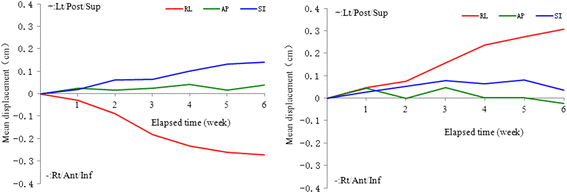Determining appropriate timing of adaptive radiation therapy for nasopharyngeal carcinoma during intensity-modulated radiation therapy
- PMID: 26377685
- PMCID: PMC4573680
- DOI: 10.1186/s13014-015-0498-1
Determining appropriate timing of adaptive radiation therapy for nasopharyngeal carcinoma during intensity-modulated radiation therapy
Abstract
Background: To determine appropriate timing of an adaptive radiation therapy (ART) replan by evaluating anatomic and dosimetric changes of target volumes and organs at risk (OARs) during intensity-modulated radiation therapy (IMRT) for nasopharyngeal carcinoma (NPC).
Methods: Nineteen NPC patients were recruited. Each patient had repeat computed tomography (CT) scans after each five fractions and at treatment completion. Automatic re-contouring the targets and OARs by using deformable registration algorithm was conducted through CT-CT fusion. Anatomic changes were assessed by comparing the initial CT and repeated CT. Hybrid plans with re-contouring were generated and the dose-volume histograms (DVH) of the hybrid plan and the original plan were compared.
Results: Progressive volume reductions in gross target volume for primary disease (GTVnx), gross target volume for involved lymph nodes (GTVnd), and parotids were observed over time. Comparing with the original plan, each hybrid plan had no significant difference in homogeneity index (HI) for all the targets. Some parameters for planning target volumes for primary disease and high-risk clinical target volume (PTVnx and PTV1, respectively) improved significantly, notably starting from the 10th fraction. These parameters included mean dose (Dmean), dose to 95% of the volume (D95), percentage of the volume receiving 95% of the prescription dose (V95), and conformity index (CI) for PTVnx, and Dmean, D95, and CI for PTV1. The dosimetric parameters for PTVnd remained the same in general except for D95 and V95 which had significant improvement at specific time points; whereas for PTV2, similar trend of dosimetric changes was also observed. Dose to some OARs increased significantly at some time points.
Conclusions: There were significant anatomic and dosimetric changes in the targets and OARs. The target dose coverage in the hybrid plans did not get worse, but overdose occurred in some critical structures. Significant dosimetric changes should be considered as a trigger point at which ART replanning is indicated. D95/V95/CI for PTV2, Dmax for the brain stem, spinal cord, right eyeball and left lens, and Dmean/V30 for the parotids and glottis were taken into account for predicting the need for ART. Two replans at the 5th and 15th fractions were suggested.
Figures
Similar articles
-
Three-Phase Adaptive Radiation Therapy for Patients With Nasopharyngeal Carcinoma Undergoing Intensity-Modulated Radiation Therapy: Dosimetric Analysis.Technol Cancer Res Treat. 2017 Dec;16(6):910-916. doi: 10.1177/1533034617709396. Epub 2017 May 17. Technol Cancer Res Treat. 2017. PMID: 28511585 Free PMC article.
-
Anatomical changes and dosimetric analysis of the neck region based on FBCT for nasopharyngeal carcinoma patients during radiotherapy.J Xray Sci Technol. 2024;32(3):783-795. doi: 10.3233/XST-230280. J Xray Sci Technol. 2024. PMID: 38457140
-
Evaluation of deformed image-based dose calculations for adaptive radiotherapy of nasopharyngeal carcinoma.Med Dosim. 2017 Winter;42(4):273-281. doi: 10.1016/j.meddos.2017.06.001. Epub 2017 Aug 3. Med Dosim. 2017. PMID: 28781156
-
Robust optimization in lung treatment plans accounting for geometric uncertainty.J Appl Clin Med Phys. 2018 May;19(3):19-26. doi: 10.1002/acm2.12291. Epub 2018 Mar 10. J Appl Clin Med Phys. 2018. PMID: 29524301 Free PMC article. Review.
-
Advances and challenges in intensity-modulated radiotherapy for nasopharyngeal carcinoma.Asian Pac J Cancer Prev. 2015;16(5):1687-92. doi: 10.7314/apjcp.2015.16.5.1687. Asian Pac J Cancer Prev. 2015. PMID: 25773811 Review.
Cited by
-
Embracing Personalized Strategies in Radiotherapy for Nasopharyngeal Carcinoma: Beyond the Conventional Bounds of Fields and Borders.Cancers (Basel). 2024 Jan 16;16(2):383. doi: 10.3390/cancers16020383. Cancers (Basel). 2024. PMID: 38254872 Free PMC article. Review.
-
Triggering daily online adaptive radiotherapy in the pelvis: Dosimetric effects and procedural implications of trigger parameter-value selection.J Appl Clin Med Phys. 2023 Oct;24(10):e14060. doi: 10.1002/acm2.14060. Epub 2023 Jun 5. J Appl Clin Med Phys. 2023. PMID: 37276079 Free PMC article.
-
Adaptive radiotherapy for head and neck cancer: Pitfalls and possibilities from the radiation oncologist's point of view.Cancer Med. 2024 Apr;13(8):e7192. doi: 10.1002/cam4.7192. Cancer Med. 2024. PMID: 38650546 Free PMC article. Review.
-
Investigating the necessity of adaptive radiotherapy in tomotherapy of head and neck cancer patients.Radiat Oncol. 2025 Jul 21;20(1):115. doi: 10.1186/s13014-025-02689-6. Radiat Oncol. 2025. PMID: 40691612 Free PMC article.
-
Comprehensive evaluation of ten deformable image registration algorithms for contour propagation between CT and cone-beam CT images in adaptive head & neck radiotherapy.PLoS One. 2017 Apr 17;12(4):e0175906. doi: 10.1371/journal.pone.0175906. eCollection 2017. PLoS One. 2017. PMID: 28414799 Free PMC article.
References
-
- Fang FM, Chien CY, Tsai WL, Chen HC, Hsu HC, Lui CC. Quality of life and survival outcome for patients with nasopharyngeal carcinoma receiving three-dimensional conformal radiotherapy vs. intensity-modulated radiotherapy-a longitudinal study. Int J Radiat Oncol Biol Phys. 2008;72:356–64. doi: 10.1016/j.ijrobp.2007.12.054. - DOI - PubMed
-
- Marucci L, Marzi S, Sperduti I, Giovinazzo G, Pinnarò P, Benassi M, et al. Influence of intensity-modulated radiation therapy technique on xerostomia and related quality of life in patients treated with intensity-modulated radiation therapy for nasopharyngeal cancer. Head Neck. 2012;34:328–35. doi: 10.1002/hed.21736. - DOI - PubMed
-
- Pow EH, Kwong DL, McMillan AS, Wong MC, Sham JS, Leung LH, et al. Xerostomia and quality of life after intensity-modulated radiotherapy vs. conventional radiotherapy for early-stage nasopharyngeal carcinoma: initial report on a randomized controlled clinical trial. Int J Radiat Oncol Biol Phys. 2006;66:981–91. doi: 10.1016/j.ijrobp.2006.06.013. - DOI - PubMed
Publication types
MeSH terms
LinkOut - more resources
Full Text Sources
Other Literature Sources


